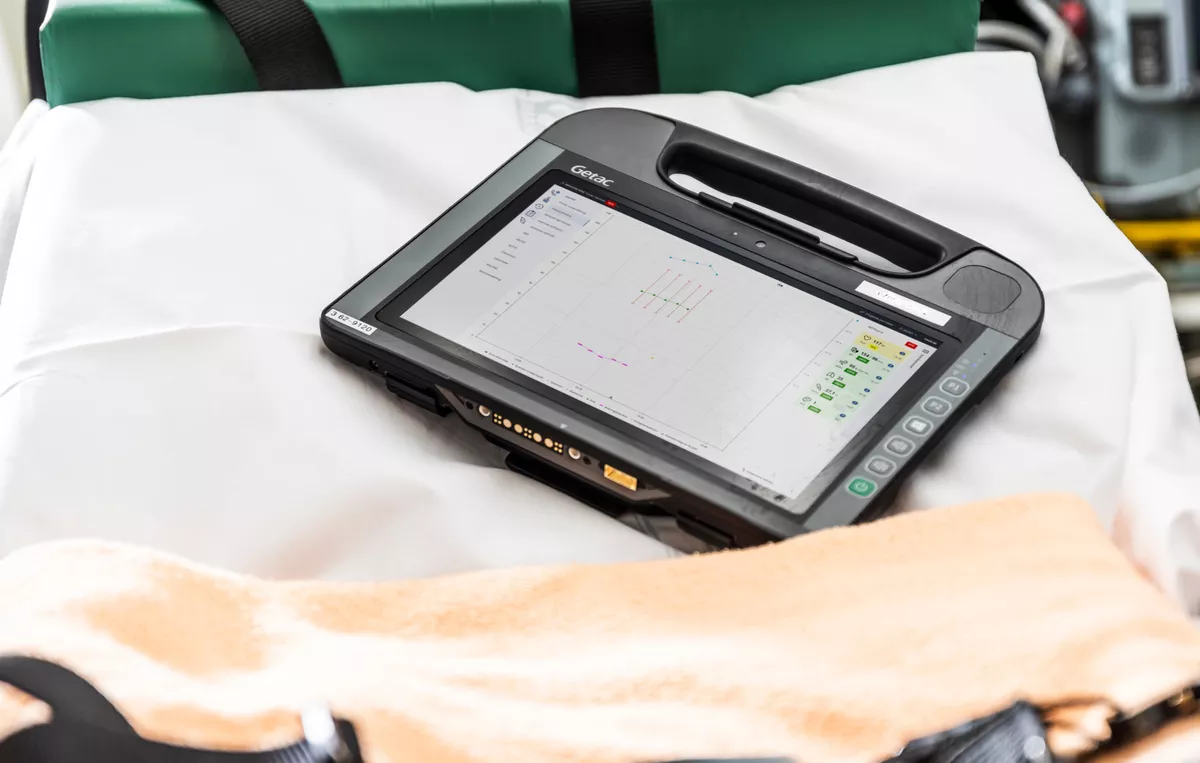Omda Paratus EMR is a workflow support system for paramedics that is used widely across ambulance services in Sweden, where 12 out of the 21 health regions have embedded the solution in their emergency care response.
In the second half of 2022, Omda released a substantial upgrade to Paratus EMR which transforms the user experience and gives paramedics access to a Knowledge Base that informs medical workflows and decision-making.
“The Knowledge Base is not a static appendix or an add-on to the system, but a vital new part of it,” says Jonas Borgström, Product Manager of Omda Paratus.

The dynamic integration between patient workflows and the Knowledge Base has been implemented across a UI upgrade that makes the platform much more transparent and intuitive. “A user interface is always relevant,” says Borgström, “but in a medical context it can really effect outcomes.”
Omda Paratus consists of two core solutions: Paratus Navigation gets the ambulance to the location of the incident as rapidly and safely as possible, while Paratus EMR helps paramedics focus on the patient as the bedside administrative and medical workflows unfold.
“All this has to happen without ambiguity or distraction,” says Borgström, who was a paramedic in Gothenburg before joining Omda. “And the UI we have now is consistent, very clean and user-friendly.”
These transformative frontend improvements are part of the recent upgrade; a longer-term objective is to release a version that is cross-platform independent, and could be run on Windows, Android, or iOS.
“That would save our customers a lot of money because a platform-agnostic system can be run on much cheaper equipment,” says Borgström.
But we should take a detailed look at the changes that are available already.
The power of the user interface
“We have new functionalities that improve patient safety and put the system more in step with standard paramedic workflows,” says Borgström. “Everything is more intuitive. The system takes the paramedic through the steps of the Advanced Medical Life Support (AMLS) workflow and depending on what you know and observe about a patient, guides you towards the right treatment options.”
Paratus EMR guides but does not dictate, because no workflow system can capture every patient and every eventuality.
The workflow starts when dispatch assigns an incident to the ambulance through Paratus Navigation which forwards data gathered by the dispatch center to Paratus EMR. Usually, this is information about the patient’s personal ID, his current condition, and any advice the nurses at dispathave given to the patient or the bystander.
“We have the patient ID in Paratus EMR but it has to be verified bedside,” says Borgström, “and this can be done in any number of ways which the system will present to you and which can include the patient’s spouse, child, or carer.”
After confirmation of the patient ID, paramedics can proceed to query two important databases for more information, as Borgström explains. “We have a registry that is local to the region. And if we can’t match the patient in that system, we go to the tax system, which is national.”
There is also a patient database with medical information: the Swedish Nationella Patient Översikten (NPÖ) or National Patient Overview. As the name implies, this database is accessible to practitioners across the health regions. “So if paramedics in Gothenburg treat a patient who is visiting from Sundsvall, they can see her medical record.
Paramedics at the scene of the incident now have a very full medical history of the patient with former diagnoses, treating doctors, prescription history and allergies, “which of course is determinant for the treatment plan to follow”.
These functionalities were available in the previous version of Paratus EMR, although the new UI improves their delivery. What is truly new is the Knowledge base.
The Paratus EMR Knowledge base
The Knowledge Base brings together all the information paramedics can use in the course of an assignment. It consists of four parts:
- Treatment guidelines
- Triage
- Medicines
- Documents
The treatment guidelines and triage categorization are standardized across Sweden, but health regions have discretion over what medicines an ambulance or paramedic crew will carry as standard. They will also issue their own authorized content as a list of links in the “Document” section of the Knowledge Base.
“The Knowledge Base is new to Paratus ERM,” says Borgström, “and we have made it possible to make everything interactive within the care process. No competitor has quite achieved this and we are well ahead of them in this area.”
So how does this work?
Workflow guidance, safer hospital handover
Omda Paratus EMR digitalizes the AMLS workflow which starts with a primary examination. The system “prompts” the clinical steps which paramedics can document intuitively mostly with yes/no answers, avoiding free text – and unstructured data – as much as possible.
“The first thing you do is a preliminary examination to determine whether the patient’s condition is critical or not. If a patient is unconscious, for instance, the platform will present the paramedic with a checklist to help ensure that the correct actions are taken. But paramedics can override these checklist suggestions because every case is different. You may need to stabilize the patient first, or there may be a massive bleed that requires you to stagger your interventions in a different order from that set out on the platform. Nothing is rigid. The system wants to guide you, not force you into a clinical straitjacket.”
The next phase of the workflow is to check the vital parameters. Paratus EMR has integrations with the different types of medical equipment used as standard by Swedish ambulance services. These will measure heart rate, body temperature, blood oxygen levels, blood pressure, breathing frequency and other vitals. “Once the readings are imported in the system we have them in our record,” says Borgström.
It is at this point that the Knowledge Base is deployed to support clinical pathways.
“What you have observed about the patient and entered into the system will now generate a number of treatment guidelines from the Knowledge Base which is integrated with the patient record,” Borgström says.
It is possible to “test” different guidelines to determine which treatment corresponds most closely to the symptoms that present themselves but as this would overly complicate our exploration of the Paratus EMR upgrade, we shall assume the treatment guideline to follow in this instance is chest pain – or “Central bröstsmärta” in our screenshot.

The choice of guidelines prompts a series of questions that will be medically consistent, and documented consistently, for all patients on the “chest pain” treatment path. For each diagnostic choice of treatment, the Knowledge Base will give you suggestions for actions, examinations, medicines, and other procedures. This creates the conditions for paramedics to be more compliant with current guidelines, and for patient care to become more equal and consistent within each health region and across Sweden itself. As always, it is important to point out that these are only suggestions and you can easily find alternative actions that you consider to be more relevant.
For instance, oxygen alone might not be enough to alleviate the symptoms of chest pain. That is a clinical judgement the system does not – and cannot – make. If morphine is indicated the system will suggest a dose based on what it knows about the patient. For elderly patients age is probably the only data point you need, and Paratus EMS will have recorded that as part of the ID verification process. “But the Knowledge Base also has a dosage calculator for age/weight which are the determinant parameters for children,” says Borgström.
The paramedic can accept or override the recommended dose, although if a certain limit is exceeded, the system will require him to get a prescription. These limits, whether for morphine or any other type of medication, are set individually by the health regions and can be customized in Paratus. “From next spring this ordering process through a doctor or hospital will be fully implemented in the system,” Borgström adds.
An ambulance-to-hospital workflow that is already part of Paratus is a checklist for admission which, again, each region determines for itself and sets up in the system individually. “We may want to take the patients directly to the cardiac department of the local hospital,” Borgström explains, “but there are criteria for that which the paramedic checks off in the system. The other huge advantage of this latest implementation of Paratus is that handover is faster and safer because the patient and treatment details are already in the system, and not scribbled on a piece of paper.”
Richer statistics, synergies across other Omda applications
Before the digitalization of these paramedic workflows, ambulance teams were expected to record incidents mostly through free text. This was less than ideal for two reasons: experienced paramedics may not necessarily be the most skillful writers (“I did not become a paramedic because I wanted to write,” Borgström comments) and, crucially, free text is unstructured and cannot be leveraged for statistical analysis. By introducing the Knowledge Base and integrating it with documentation workflows, the upgrade to Paratus EMR opens up many more possibilities for data aggregation and analysis.
“The Paratus EMR statistical database is an important part of what we do,” says Borgström. “We already have structured data that we forward once a year to a Swedish ambulance register.”
The Knowledge Base will make how and what paramedics document in the course of an incident dramatically more consistent, structured, and complete.
“We already collect all the data and clean it before we put it in our statistical database, so it’s quite reliable. The upgrade will over time give our customers much deeper insights into the deployment of ambulance and paramedic resources – and it is in this area that we see a great potential of synergies with Optima Predict.”
Part of the Omda portfolio of Public Safety solutions that also includes Paratus Navigation and EMR, Optima Predict is a planning and forecasting tool that helps ambulance services optimize their resources.
“The structured data derived from the Knowledge Base could be deployed to great effect by Optima Predict, and we are already trialing this in one Swedish health region. Our Optima/Paratus pilot is a great example of how we can collaborate across Omda applications, and this approach holds incredible promise for the future of Omda, but also of the ambulance services in Sweden and elsewhere.”
Conclusion
The recent upgrade to Paratus EMR is the most far-reaching Omda has implemented to date for the solution. Ambulance services across Sweden are rolling out the upgrade and experiencing the immediate benefits of a user interface that is more transparent and direct.
The Knowledge Base and especially its integration with “the task at hand”, treating the patient, will prove increasingly invaluable to how paramedics make decisions – and document them.
The promise of rich structured data across the entire paramedic workflow has incredible potential in helping the region understand the correlations between patient profiles, treatment paths, and medical outcomes. Perhaps more immediately, EMR data can be leveraged to help ambulance services strategically improve deployment of their resources.
We have only been able to scratch the surface of the many ways in which the Knowledge Base will prove to be a step-change in how paramedics work. “It has created so many functional and strategic opportunities, we already have a bunch of additional upgrades in the pipeline. And as we work through the implementation of the upgrade, and also the trial with Optima Predict, I am sure that we will discover more use cases and explore more synergies with other Omda applications.”
“We’re not done yet,” Borgström concludes. “There’s more to come.”
